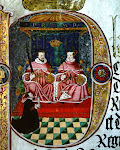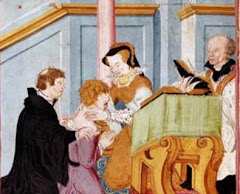Mary would act as the nominal head of a new Council of Wales and preside over an impressive household. Ludlow Castle is often identified in discussions on Mary’s progress to the Welsh Marches as being her principal seat. Yet her time there was short lived, evidenced in an itinerary of her journey established by W. R. B Robinson. According to Robinson,
As her biographers have assumed that Ludlow castle was her principal residence during her stay in the Marches, it should be noted that the evidence for her presence there in early May 1526 is indirect and that no other evidence for her being at Ludlow has been found. Robinson, 'Princess Mary's Itinerary in the Marches of Wales 1525–1527: a Provisional Record', Historical Research, 71, 175 (2002), p.239.
In the itinerary, Robinson has identified that on the 3rd and 4th May 1526, Mary’s governess, Margaret Pole, Countess of Salisbury, is noted to have been present at Ludlow inferring that Mary was also there. That is the only evidence of Mary’s stay at the castle. A letter from the president of the council in the marches of Wales and supervisor of Mary’s household, John Veysey, bishop of Exeter, indicates that there was plague nearby and subsequently there were concerns for Mary’s health. Veysey wrote to Wolsey alerting him of the numerous local areas inflicted by illness, a worry given that many had travelled from thereabouts to Ludlow in order to pay homage to the princess and advance respective petitions. The presence of the king’s daughter, and in many people’s eyes the de facto Princess of Wales, naturally excited many and drew crowds. Mary was Henry’s only legitimate child; her health was of extreme importance. So Wolsey recommended that Mary be moved from the council to some ‘place solitary’. The location of this site is unknown, though clearly Mary left Ludlow. Mary is next mentioned at Hartlebury, and then progressed on to Worcester, thus making her route back to Greenwich Palace. She was back there for St George’s Day 1527.
Yet Mary did stay at Ludlow, like her mother around twenty-five years before her. Katherine had gone as the official Princess of Wales, married to the heir to the throne, Arthur, son of Henry VII. Like her daughter, Katherine’s stay at Ludlow was limited though longer than Mary’s. Katherine arrived at Ludlow in December 1501 and on 2nd April 1502 Arthur died, possibly of the sweating sickness or some other virulent disease. News from Veysey of illness in the surrounding areas must have revived unpleasant memories.
Ludlow today lies in ruins. Situated in one of the most beautiful counties in England and affixed to a picturesque town, Ludlow Castle is the ideal tourist attraction. A while back I decided to visit as many of Mary’s pre-accession households as possible and, having never been to Ludlow, I made a trip last Saturday. Here are some photos I took of the castle:



The judges' lodgings; lodgings for administrators including those that accompanied Mary to Ludlow. On the walls you can see remains of fireplaces, marking the level of floors once present.

Stairs of the Judges' lodgings

The Round Chapel. Dating to the eleventh-century, the chapel was dedicated to St Mary Magdelene and originally had a square chancel with a polygonal apse, the foundations of which can still be seen. For many years it was known as Prince Arthurs Chappel, after Arthur Tudor, who worshiped there along with his household.

The north range. The stairs lead to the Great Hall, the centre of Ludlow Castle and of Mary’s household. The Great Chamber is situated to the right, and was used as the Lord President’s apartments (I think Katherine of Aragon’s apartments were situated here). Prince Arthur’s apartments were alleged to the left – the western solar block. These grand apartments may have been used by Mary during her stay.

Detail of the western apartments that may have been used by Mary. Here are remains of a grand fireplace.

Further detail of the western apartments

Detail of the Great Hall, the centre of Mary’s household.

View of Ludlow from the castle. The church is St Laurence’s. Arthur Tudor’s heart was buried there; his body lies in Worcester Cathedral.

Modern portrait of Mary in Castle Lodge, Ludlow. Appears to be based on the c.1544 portrait of Mary by ‘Master John’ (National Portrait Gallery, London).
For further reading see: Jeri L. McIntosh,'Princess Mary as the de facto Prince(ss) of Wales, 1525' (2010)




No comments:
Post a Comment